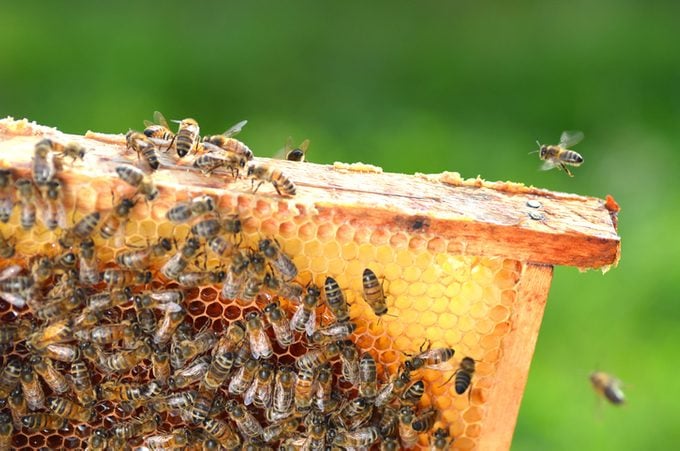Here’s Why You Shouldn’t Put Up Honey Bee Hives
Updated: Oct. 26, 2023

Honey bees are a worthy hobby for some. But if conservation is your goal, you're buzzing around the wrong hive.
Worries about pollinator decline created a beekeeping boom, with concerned humans putting up hives in gardens and on rooftops. But while all of those honey bees are charismatic and entertaining, they’re not actually helping conservation. In some instances, they’re actually doing more harm than good by putting more pressure on native bee species.
That’s because in North America, honey bees are essentially domesticated livestock. So getting a hive doesn’t address the root causes of wild pollinator decline — things like pesticides, habitat loss, climate change and disease.
Nonetheless, the pop-culture craze to save the bees started with a focus on honey bees, probably in part because of news coverage about colony collapse disorder, a phenomenon specific to that species. As more people jumped on that bandwagon, the movement became more entrenched in a misleading direction.
“Everyone has seen a honey bee hive, and I would guess that most people, including celebrities, influencers and corporations, don’t even know there are different species of bees, or that honey bees are not native,” says Rich Hatfield, senior conservation biologist with the Xerces Society for Invertebrate Conservation.
“I believe that commercial buildings can still get LEED credits for having a honey bee hive on their property. This is truly amazing to me, as it is definitely not sustainable, nor practicing sustainability.”
Here’s why putting up a honey bee hive isn’t the best course for conservation, as well as what to know if you still want one.
On This Page
Honey Bees Can Disrupt Native Plant Diversity
Honey bees are vital for pollinating many of our crops, but they’re not actually native to North America. European colonists brought them here in the 1620s. Native bees, on the other hand, coevolved alongside America’s native plants.
Because many native flowers depend on pollination services only native bee species can provide, plant diversity decreases in areas dominated by honey bees, and invasive and non-native plants increase. Less plant diversity alters pollination networks, diminishing the diversity of other pollinators like butterflies and moths.
Keeping Bees is Agriculture, Not Conservation
If your goals are producing your own honey and learning about a fascinating social insect, then beekeeping is a great hobby.
“But if your goal is conservation,” says Hatfield, “hosting a hive of honey bees in your backyard to save the bees is akin to hosting a chicken coop in your backyard to save song birds.” It might even worse, Hatfield says, since “chickens don’t take resources from native birds, nor are they likely to pass diseases to them as they don’t interact much.”
Honey Bees Take Resources From Native Bees
Honey bees consume pollen and nectar, leaving less for native bees. That’s especially harmful in places where natural resources are not plentiful. One study calculated that over three months, a honey bee hive can collect enough pollen to support the development of 100,000 native solitary bees.
Honey Bees Can Spread Disease to Native Bees
Concentrated populations of honey bees are more likely to amplify diseases that can spread to wild bee populations. Diseases like deformed wing virus are significant factors in the decline of some bumble bees and other native bee species.
Honey Bees Are Not Endangered
Honey bees are facing challenges, but they’re not threatened by extinction the way some native bees are. However, a confused conservation message is taking money, attention and other resources and actions away from the true problem.
How To Help Native Bees
The biggest threats to native bees are pesticides, diseases and lack of diverse plants to forage. So the best way to help native bees (which also helps honey bees) include:
- Plant native plants and flowers with diverse sizes, shapes and colors, which bloom at various times throughout the growing season.
- Create nesting and overwintering habitat for bees that includes access to bare ground, hollow stems, dead tree branches and leaf litter.
- Ditch pesticides. Instead, create a diverse, ecologically balanced habitat that supports other beneficial insects that prey on parasites and other pests.
When Is Beekeeping OK?

If you want to produce your own honey and learn from a social insect, having a hive won’t lead to the demise of native bees.
“Because honey bees are so accessible to the public and make people more aware of these issues and the needs of pollinators, they work as a gateway bug to protecting and advocating for native bees and other pollinators,” says Lorna McCallister, an instructor for Beekeeping Bootcamp at the Butterfly Pavilion in Westminster, Colorado.
Hatfield agrees. “There are plenty of reasons to keep honey bees,” he says. “Conservation is just not one of them.
“Those of us singing from the rafters about this issue don’t have any ill feelings towards honey bees, or honey beekeepers. We’re simply advocating that the agricultural sector do a better job of protecting the animals they depend on for pollination by having more sustainable agricultural practices and healthier landscapes.”
If you want a hive, study up on best beekeeping practices, for the success of your honey bees and the native bees in your neighborhood.
